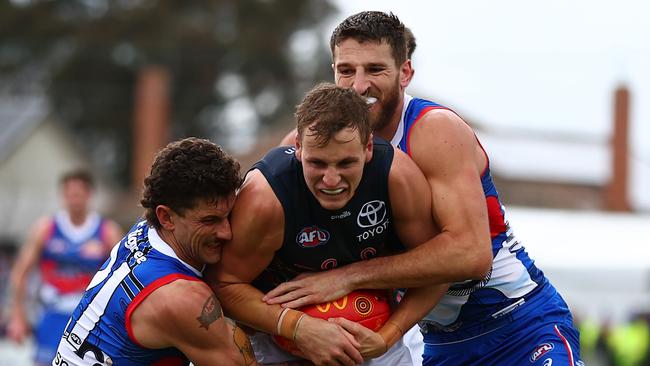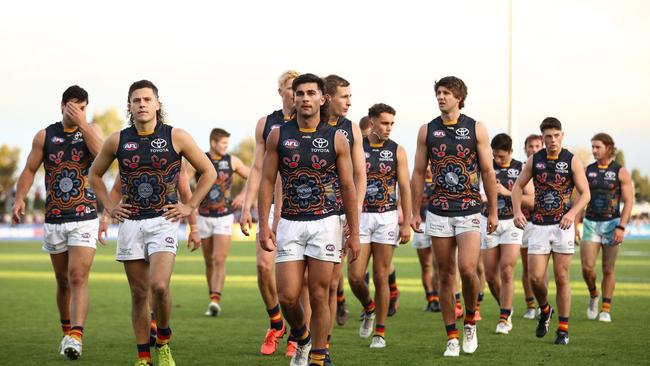The Adelaide Crows have no business playing in Ballarat | Graham Cornes
If anyone still needed proof of the AFL still thinks it's the VFL, this game was it, writes Graham Cornes.
Opinion
Don't miss out on the headlines from Opinion. Followed categories will be added to My News.
The Crows came crashing back to reality as they were outworked, outplayed and beaten by the superior skills of the Western Bulldogs. However, they should never have had to play that game in Ballarat.
If ever the football world needed further proof the AFL is still nothing more than an extended VFL, this match was it. Once again, it’s the Crows who had to do the heavy lifting, simply because the Bulldogs have a sponsorship arrangement with the city of Ballarat. Why? Because in 2017 the Victorian government pledged to spend $31.5 million to upgrade the Ballarat Major Events Precinct, $15 million of which was spent on the old North Ballarat Oval, which is now called Mars Stadium.
Throw money at it and call it a fancy name, but it’s still a Victorian country footy ground exposed to the elements of Victorian country weather conditions. Actually, unlike the Ballarat City Oval with its heritage-stye grandstand, it never had the ambience of a traditional football ground. Sure, it was the home of the North Ballarat Football Club but it was also used as trotting track and showgrounds. Money can never buy character.
To add insult to injury, the Bulldogs get the money and the Adelaide Football Club receive no benefit for the sacrifice.
There is no financial incentive or reward and no concessions given to programming. For instance, the Adelaide Football Club asked for its home Showdown against Port in round 20 this year to be a stand-alone Friday night match. It was not granted.
If the Victorian government and the city of Ballarat really wanted to maximise its sponsorship dollar why aren’t the other traditional Melbourne clubs scheduled to play there?

Imagine the interest if Collingwood, Carlton or St Kilda were scheduled to play an AFL match for premiership points in Ballarat? Then imagine the outcry. It’s only a 90-minute drive up the freeway but those cosseted Victorian footballers would have separation anxiety if they had to leave their comfortable refuge of the MCG.
Collingwood, Carlton and Richmond seem always to be the beneficiaries of AFL scheduling. The absolute majority of their games are in Melbourne, either at the MCG or at the Docklands stadium. At the business end of the season, leading into finals, they rarely venture outside of Melbourne. It’s an enormous advantage. Wouldn’t the Ballarat crowd love to see one of those teams in action in their city?
Similarly, down in Tasmania, both Hawthorn and North Melbourne have sponsorship arrangements with the Tasmanian government. Inevitably, it’s the Crows, Port or other non-Victorian clubs who end up either in Launceston or Hobart at least once a year; Collingwood rarely.
In the formative years of both the West Coast Eagles and the Adelaide Football clubs, when the teams had to play the Victorian teams on their traditional suburban home grounds, the advantage was significant. Collingwood played at Victoria Park; Essendon at Windy Hill; Carlton at Princes Park; St Kilda at Moorabbin; Footscray at the Western Oval, and worst of all, Geelong at Kardinia Park.
They were all historic ovals steeped in football history but the facilities and surface conditions of their ovals were archaic. They were killing fields for the non-Victorian teams. And the behaviour of the crowds was appalling, particularly at Victoria Park and Moorabbin.
The record books tell the sad story. At Windy Hill in round 15 of the third season of the West Coast Eagles they only scored one goal. In their premiership year of 1992, they could only manage three goals at the Western Oval. Similarly, the Crows would be hammered at those Victorian suburban grounds – by 131 points against St Kilda at Moorabbin and 123 points against Collingwood at Victoria Park and of course Geelong by 123 points at Kardinia Park! The rationalisation of the Melbourne grounds, which saw the passing of the suburban grounds in Melbourne has helped to neutralise the advantage of the Victorian-based teams, but it’s still significant.
We tried any number of different tactics and preparations to try and lessen the impact of travelling to hostile grounds. We experimented with different travelling schedules, different accommodations, meals, meetings and uniforms in which to travel, without much effect.
How ironic these days to see the relaxed manner of players in their tracksuits, shorts and polo shirts as they nonchalantly board the planes for their interstate fixtures.
It’s a far cry from the days when, for the image of the club, we insisted they wear club blazer and ties. The relaxed dress code is part of the strategy to overcome the travel factor. Clubs have specialists who work on the psychological preparation for interstate matches.
Most clubs today have a weekly theme around which they prepare the team for upcoming matches. It was no different in the formative years of the Crows, whether those games were interstate or in the least desirable of timeslots on the weekend.
(We often seemed to get the Sunday evening games which were the worst of all for semi-professional footballers who still had a day job). Occasionally those themes and strategies worked. From memory, the simplest one was the most effective.

Matthew Liptak, one of the more intelligent footballers to play at an AFL club came up with a three-word sentence: “Anywhere, Anytime, Anyhow.”
It distils the issue and crystallises it to its simplest form. Regardless of conditions, venue, timeslots or opponents, there can be no excuses.
The job just has to be done. It works from time to time but unfortunately, the record books tell the complete story.
The team with the home interstate venue has a statistical advantage.
History tells us there is no proven method for winning interstate other than assembling a powerful team. West Coast did it, Brisbane did it, Sydney did it, Port Adelaide did it and the Crows did it for those two glorious years in 1997 and 1998.
In a national competition with 10 of the 18 teams based in Victoria, there was always going to be a distinct advantage to those teams.
Instead of attempting to equalise the competition, the AFL accentuates that advantage by favouring the Victorian-based clubs in its scheduling. They get the bulk of the premium timeslots, venues and stand-alone television telecasts.
Strong teams like Collingwood, Richmond, Melbourne, and in the past Hawthorn, have the enormous advantage of playing at the MCG in their run home to the finals.
If it is true that AFL executives are paid based on key performance indicators such as attendances, and television audiences it explains the favouritism but doesn’t excuse it. However, it doesn’t explain why Carlton, a perennial struggler in recent years, gets the prime timeslots.
Having to play in Ballarat isn’t the reason the Crows lost on Saturday. After all they were impacted by injuries and were playing a team that once again has realistic finals aspirations. However enough is enough. It’s time some of those pampered Melbourne-based teams were shaken from the comfort zones of the MCG and Docklands and travelled up the highway to Ballarat.
They should feel right at home.





